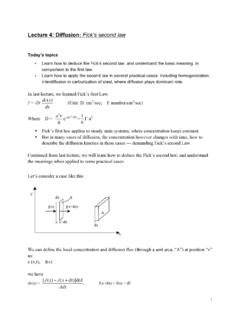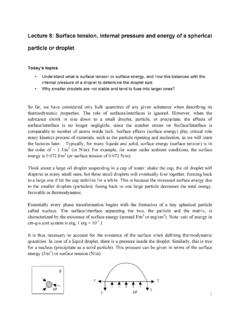Transcription of Lecture 19: Eutectoid Transformation in Steels: a typical ...
1 Lecture 19: Eutectoid Transformation in Steels: a typical case of Cellular Precipitation Today's topics Understanding of Cellular Transformation (or precipitation): when applied to phase Transformation from austenite to pearlite in iron-carbon (Fe-C) steel , such a Transformation is also often called Eutectoid Transformation . Understanding of the different phases of iron-carbon (Fe-C) steel . What is the Eutectoid Transformation ? How to understand such a Transformation in Fe-C. steel , particularly regarding the phase diagram? About cellular Transformation (or precipitation). Cellular Transformation can be in the type of or + , where all of the parent phase is consumed by the Transformation product, and the Transformation does not terminate by the gradual reduction in the growth rate, but by the impingement of adjacent cells growing with a constant velocity (see Figure below, cited from the Book, "Phase Transformations in Metals and Alloys", by D.)
2 A. Porter, K. E. Easterling and M. Y. Sherif, CRC Press, third edition.). Since the new phase ( or ) forms by precipitation from the parent phase ( ) upon cooling, cellular Transformation is also often called Cellular precipitation. The essential feature of this type of Transformation is that the boundary moves with the growing tips of the precipitates as shown in Figure (below, cited from the same Book above). The growth of cellular precipitates requires the portioning of solute to the tips of the precipitates in contact with the advancing grain boundary. This can occur in one of the two ways: either by diffusion through the lattice ahead of the advancing cell front, or by diffusion in the moving boundary. The mechanism whereby grain-boundary nucleation develops into cellular precipitation differs from one alloy to another and is not always fully understood.
3 The reason why cells develop in some alloys but not in others also remains unclear. Several terms used in iron-carbon (Fe-C) alloys: the steels Several terms used in iron-carbon (Fe-C) alloys: Ferrite ( -iron), Austenite ( -iron), Cementite (iron carbide, Fe3C), Pearlite (88wt% ferrite, 12wt% cementite, or iron, carbon), Bainite, Martensite, Ledeburite (ferrite-cementite eutectic, carbon). Ferrite: the -iron, is a materials science term for iron, or a solid solution with iron as the main constituent, with a body centred cubic (bcc) crystal structure. It is the component which gives steel and cast iron their magnetic properties, and is the classic example of a 1. ferromagnetic material. Practically speaking, ferrite can be considered pure iron.
4 Ferrite is stable below 910 C (1,670 F). Above this temperature the face centered cubic (fcc). form of iron, austenite ( -iron), is stable. Above 1,390 C (2,530 F), up to the melting point at 1,539 C (2,802 F), the body centered cubic (bcc) crystal structure is again the more stable form for delta-ferrite ( -Fe). Only a very small amount of carbon can be dissolved in ferrite; the maximum solubility is about wt% at 723 C (1,333 F) and carbon at 0 C (32 F). This is because carbon dissolves in iron interstitially, with the carbon atoms being about twice the diameter of the interstitial "holes", so that each carbon atom is surrounded by a strong local strain field. Hence the enthalpy of mixing is positive (unfavourable), but the contribution of entropy to the free energy of solution stabilizes the structure for low carbon content.
5 Pearlite: is a two-phased, lamellar (or layered) structure composed of alternating layers of ferrite (88 wt%) and cementite (12wt%) that occurs in some steels and cast irons. During slow cooling pearlite forms by a Eutectoid reaction as austenite is cooled below 727 C (the Eutectoid temperature). See Figure (below, cited from the same Book above) for the lamellar microstructure of Pearlite. Mild steel (carbon steel with up to about wt% C) consist mostly of ferrite, where the amount of pearlite increases with increasing the carbon content is increased. Austenite: the -iron, is a metallic non-magnetic allotrope of iron or a solid solution of iron, with an alloying element (typically carbon). In plain-carbon steel , austenite exists above the critical Eutectoid temperature of 727 C); other alloys of steel have different Eutectoid temperatures.
6 It is named after Sir William Chandler Roberts-Austen (1843-1902). Cementite: iron carbide (Fe3C), is a chemical compound of an orthorhombic crystal structure. It is a hard, brittle material, normally classified as a ceramic in its pure form, though it is more important in metallurgy. Cementite forms directly from the melt in the case of white cast iron. In carbon steel , it either forms from austenite during cooling or from martensite during tempering. An intimate mixture with ferrite, the other product of austenite, forms a lamellar structure called pearlite. Much larger lamellae, visible to the naked eye, make up the structure of Damascus steel . Martensite: named after the German metallurgist Adolf Martens (1850 1914), most commonly refers to a very hard form of steel crystalline structure, but it can also refer to any crystal structure that is formed by displacive Transformation .
7 Martensite is not shown in the equilibrium phase diagram of the iron-carbon system because it is a metastable phase, the kinetic product of rapid cooling of steel containing sufficient carbon. Bainite: first described by E. S. Davenport and Edgar Bain, is a phase that exists in steel microstructures after certain heat treatments. Bainite is one of the decomposition products that may form when austenite is cooled past the Eutectoid temperature of 727. C. appearing as a fine non-lamellar structure, bainite commonly consists of ferrite, carbide, and retained austenite. In these cases it is similar in constitution to pearlite, but with the ferrite forming by a displacive mechanism similar to martensite formation, usually followed by precipitation of carbides from the supersaturated ferrite or austenite.
8 The 2. temperature range for Transformation to bainite is between those for pearlite and martensite. When formed during continuous cooling, the cooling rate to form bainite is higher than that required to form pearlite, but lower than that to form martensite, in steel of the same composition. 3. Some basics about Eutectoid Transformation in Fe-C alloy ( steel ). A eutectic system is a mixture of chemical compounds or elements that has a single chemical composition that solidifies at a lower temperature than any other composition. This composition is known as the eutectic composition and the temperature is known as the eutectic temperature. On a phase diagram the intersection of the eutectic temperature and the eutectic composition gives the eutectic point.
9 Not all binary alloys have a eutectic point, for example, the gold-silver system does not have eutectic point. The eutectic Transformation is usually defined as: This type of Transformation is an invariant reaction, because it is in thermal equilibrium, , the Gibbs free energy change equals zero. This means the liquid and two solid solutions all coexist at the same time and are in chemical equilibrium. When the solution above the Transformation point is solid, rather than liquid, an analogous Eutectoid Transformation can occur. For instance, in the iron-carbon (Fe-C). system, the austenite phase can undergo a Eutectoid Transformation to produce ferrite 4. and cementite, often in lamellar structures such as pearlite. This Eutectoid point occurs at 727 C (1,341 F).
10 The Eutectoid composition of austenite is approximately carbon; steel with less carbon content will contain a corresponding proportion of relatively pure ferrite crystallites that do not participate in the Eutectoid reaction and cannot transform into pearlite. Likewise steels with higher carbon contents will form cementite before reaching the Eutectoid point. In last three Lectures 16-18: We have examined the kinetics of phase growth for , where phase precipitates out of the original, supersaturated phase as particles. As more and more phase forms, , as X(t) increase, it depletes the . phase in the immediate vicinity. As the -particle becomes larger, the concentration gradient to the growing particle becomes smaller.









